
A planning method called curriculum mapping makes sure that the course's learning objectives are taught to the students. A curriculum map is often a visual depiction of the complicated curriculum that enables teachers to determine the appropriate timing for instruction and assessment.
However, there are several ways by which it can be made and initiated in special education classrooms. Educators with online special education courses find linkages between learning objectives and any structural gaps in the curriculum with the use of an effective curriculum map. Keep reading on to know more about curriculum mapping, its purpose, and implications.
What Do You Mean By Curriculum Mapping?
A thorough approach to charting learning goals, exercises, materials, and tests for a class or grade level is called curriculum mapping. It is a tool that assists teachers in locating and correcting redundancies, misalignments, and omissions in a course.
Curriculum mapping helps to improve a learning program's overall efficacy and coherence. An effective curriculum map takes into account the student's aptitudes, learning goals, mastery expectations, and course content.
Furthermore, effective curriculum maps:
What Is The Purpose Of Curriculum Mapping?
When a curriculum map is finished, teachers can evaluate or share lessons that they or another person have previously put into practice. Maps of the curriculum can also be utilized as a planning tool to guide instruction in the future.

Curriculum mapping serves to enhance overall coherence from grade to grade in addition to supporting reflective practice and improved faculty communication. This increases the possibility that students will meet program- or school-level objectives.
Do you follow us on Social Media? We regularly share upgraded educational content, tips, feedback, and more. Check us out by clicking the profiles here - Facebook / Twitter / LinkedIn / Pinterest / Instagram / YouTube
What Are The Types Of Curriculum Mapping?
There are two different types of curriculum approaches that educators approach. They are:
How To Initiate Curriculum Mapping?
Here are a few steps you need to follow to create effective curriculum mapping for your classroom:
Tips To Map A Curriculum For Guaranteed Success
Here are a few tips to successfully go through the process of creating a curriculum map for all the courses that you teach:
Use Curriculum Mapping For Effective Learning
A systematic, data-driven approach to curriculum design and implementation is offered by curriculum mapping. The methods and recommendations provided help teachers streamline the procedure, guarantee consistency, and promote data-driven decision-making. If you are yet to start your SEN teacher journey, ensure that you pursue Offline or Online Special Education Courses to process the continuous demands of enhancement finally elevating students’ educational experience.
We believe education should be accessible for everyone. That’s why we don’t charge for our blogs. Find the right course that will help you in your career with us, contact us at 91-6292150868. You can mail us at act@asiancollegeofteachers.com
Get In Touch
UK – Registered OfficeAsian College Of Teachers Ltd (UK)
27, Old Gloucester Street, London – WC1N 3AX, UK
UK Toll Free: 0-808-189-1203
www.asiancollegeofteachers.co.uk
All SEN Courses are designed, developed and created by Asian College of Teachers Ltd, United Kingdom. These courses are certified by CPD Certification Service UK and endorsed by NCC Education, UK, and Short Courses from CACHE, UK through Laser Learning UK.
Asian College of Teachers (ACT) undertakes a continuous review of its teacher training courses to ensure imparting high quality education. However, there might be circumstances outside of ACT’s control which might affect its stakeholders like if you are planning to teach in a different country, applying for a teaching license, pursuing higher studies or trying to get the certificate approved by the Ministry of Education (MoE) of a particular country then you can do so with the certificate issued by Asian College of Teachers (ACT). However, each country’s Ministry of Education (MoE) or educational bodies set certain standards that are indispensable for the pursuit of higher studies or teaching in schools in that country. So it can be a possibility that you may be able to use the certificate for higher studies or teaching purposes in one country and not in another. Therefore, we strongly recommend that you investigate thoroughly and check with the relevant authorities regarding the acceptance of the certificate issued by us before you enrol on a particular course. ACT strives to offer high-quality education and its certificates can be valuable for various purposes internationally, but still it is crucial for individuals to verify the specific recognition of the certificate in the country they intend to use it, especially for formal education or professional licensing purposes. This approach ensures that the stakeholders make informed decisions regarding their educational and career paths.
© 2024 Asian College of Teachers. All Rights Reserved. Asian College Of Teachers is a trading brand of TTA Training Pvt. Ltd (India) - CIN U80902WB2016PTC215839, Asia Teachers Training Co., Ltd (Thailand) - Registration No. 0105558193360, Asian College Of Teachers Ltd (UK) - Company Number 9939942 & Asian College Of Teachers LLC, (USA) - Federal Tax Identification Number 30-1261596
Designed by kreativewebtech